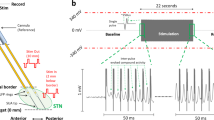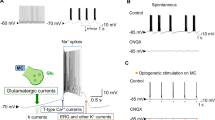Abstract
Background
Recently, therapeutic attempts to control motor choreatic hyperkinesia of Huntington’s disease (HD) by means of pallidal deep brain stimulation (Gp-DBS) were successful. With respect to the clinical effects of Gp-DBS in juvenile hypokinetic-rigid HD (jHD; Westphal variant), only one single-case has been reported up to date. Oscillatory patterns of the Gp in jHD are not known.
Objectives and methods
This work aimed to analyse pallidal local field potential oscillations (LFP) in two patients with jHD treated with Gp-DBS. Safety data and clinical scores up to 12 months after DBS-electrode implantation were collected in the framework of a prospective trial (ClinicalTrials.gov; NCT00902889).
Results
Intraoperative LFP revealed local alpha and beta oscillations similar to those found in other movement disorders with akinetic rigid and dystonic presentation. Significant motor improvement was not found. There were no treatment-related complications or unresolved long-term adverse events.
Conclusions
In spite of similar intraoperative LFP patterns of jHD with those of movement disorders benefitting from DBS, clinical results were not convincing in our patients, so that Gp-DBS in jHD cannot be generally recommended.


Similar content being viewed by others
References
Bordelon YM (2013) Clinical neurogenetics: Huntington disease. Neurol Clin 31:1085–1094
Quarrell O, O’Donovan KL, Bandmann O et al. The prevalence of juvenile Huntington’s disease: a review of the literature and meta-analysis. PLoS Curr 2012;4:e4f8606b742ef3
Moro E, Lang AE, Strafella AP et al (2004) Bilateral globus pallidus stimulation for Huntington’s disease. Ann Neurol 56:290–294
Temel Y, Cao C, Vlamings R et al (2006) Motor and cognitive improvement by deep brain stimulation in a transgenic rat model of Huntington’s disease. Neurosci Lett 406:138–141
Biolsi B, Cif L, Fertit HE et al (2008) Long-term follow-up of Huntington disease treated by bilateral deep brain stimulation of the internal globus pallidus. J Neurosurg 109:130–132
Fasano A, Mazzone P, Piano C et al (2008) GPi-DBS in Huntington’s disease: results on motor function and cognition in a 72-year-old case. Mov Disord Off J Mov Disord Soc 23:1289–1292
Ligot N, Krystkowiak P, Simonin C et al (2011) External globus pallidus stimulation modulates brain connectivity in Huntington’s disease. J Cereb Blood Flow Metab 31:41–46
Edwards TC, Zrinzo L, Limousin P et al (2012) Deep brain stimulation in the treatment of chorea. Mov Disord 27:357–363
Spielberger S, Hotter A, Wolf E et al (2012) Deep brain stimulation in Huntington’s disease: a 4-year follow-up case report. Mov Disord 27:806–807 (author reply 807–8)
Gruber D, Kuhn AA, Schoenecker T et al (2014) Quadruple deep brain stimulation in Huntington’s disease, targeting pallidum and subthalamic nucleus: case report and review of the literature. J Neural Transm 1996 121:1303–1312
Beste C, Mückschel M, Elben S et al (2015) Behavioral and neurophysiological evidence for the enhancement of cognitive control under dorsal pallidal deep brain stimulation in Huntington’s disease. Brain Struct Funct 220:2441–2448
Wojtecki L, Groiss SJ, Ferrea S et al (2015) A prospective pilot trial for pallidal deep brain stimulation in Huntington’s disease. Front Neurol 6:177
Cislaghi G, Capiluppi E, Saleh C et al (2014) Bilateral globus pallidus stimulation in Westphal variant of huntington disease. Neuromodulation 17:502–505
Kieburtz K, Penney JB Jr, Como P, Ranen N, Shoulson I (1996) Unified Huntington’s Disease Rating Scale: reliability and consistency. Huntington Study Group. Mov Disord Off J Mov Disord Soc 11:136–142
Mattis S (1976) Mental status examination for organic mental syndromes in the elderly patient. In: Bellak L, Karasu TE (eds) Geriatric Psychiatry. A handbook for psychiatrists and primary care physicians, Grune and Stratton, New York, pp. 77–101
Siesling S, Zwinderman AH, van Vugt JP et al (1997) A shortened version of the motor section of the Unified Huntington’s Disease Rating Scale. Mov Disord 12:229–234
Burke RE, Fahn S, Marsden CD et al (1985) Validity and reliability of a rating scale for the primary torsion dystonias. Neurology 35:73–77
Goetz CG, Fahn S, Martinez-Martin P et al (2007) Movement Disorder Society-sponsored revision of the Unified Parkinson’s Disease Rating Scale (MDS-UPDRS): process, format, and clinimetric testing plan. Mov Disord 22:41–47
Wojtecki L, Groiss SJ, Hartmann CJ et al (2016) Deep brain stimulation in Huntington’s disease-preliminary evidence on pathophysiology, efficacy and safety. Brain Sci Aug 30;6(3). pii: E38. https://doi.org/10.3390/brainsci6030038
Brown P, Williams D (2005) Basal ganglia local field potential activity: character and functional significance in the human. Clin Neurophysiol 116:2510–2519
Chen CC, Kühn AA, Hoffmann K-T et al (2006) Oscillatory pallidal local field potential activity correlates with involuntary EMG in dystonia. Neurology 66:418–420
Liu X, Wang S, Yianni J et al (2008) The sensory and motor representation of synchronized oscillations in the globus pallidus in patients with primary dystonia. Brain J Neurol 131:1562–1573
Hirschmann J, Özkurt TE, Butz M et al (2011) Distinct oscillatory STN-cortical loops revealed by simultaneous MEG and local field potential recordings in patients with Parkinson’s disease. Neuroimage 55:1159–1168
Jenkinson N, Kühn AA, Brown P (2013) γ oscillations in the human basal ganglia. Exp Neurol 245:72–76
Liu X, Ford-Dunn HL, Hayward GN et al (2002) The oscillatory activity in the Parkinsonian subthalamic nucleus investigated using the macro-electrodes for deep brain stimulation. Clin Neurophysiol 113:1667–1672
Silberstein P, Kühn AA, Kupsch A et al (2003) Patterning of globus pallidus local field potentials differs between Parkinson’s disease and dystonia. Brain J Neurol 126:2597–2608
Weinberger M, Hutchison WD, Alavi M et al (2012) Oscillatory activity in the globus pallidus internus: comparison between Parkinson’s disease and dystonia. Clin Neurophysiol 123:358–368
Brown P, Oliviero A, Mazzone P et al (2001) Dopamine dependency of oscillations between subthalamic nucleus and pallidum in Parkinson’s disease. J Neurosci 21:1033–1038
Levy R, Ashby P, Hutchison WD et al (2002) Dependence of subthalamic nucleus oscillations on movement and dopamine in Parkinson’s disease. Brain J Neurol 125:1196–1209
Stein E, Bar-Gad I (2013) β oscillations in the cortico-basal ganglia loop during parkinsonism. Exp Neurol 245:52–59
Groiss SJ, Elben S, Reck C et al (2011) Local field potential oscillations of the globus pallidus in Huntington’s disease. Mov Disord 26:2577–2578
Acknowledgements
We thank the patients and their caregiver for the cooperation. We further thank the following persons for organizational and statistical support: M. Schulz (Department of Neurology, Medical Faculty, Heinrich-Heine-University Düsseldorf, Germany); M. Blicke (Institute of Clinical Neuroscience and Medical Psychology, Medical Faculty, Heinrich-Heine-University Düsseldorf, Germany); Ch. Ohmann, G. Felder, Q. Yang, M. Partowinia-Peters (KKS, Medical Faculty, Heinrich-Heine-University Düsseldorf, Germany); C. Schade-Brittinger (KKS Marburg).
Members of the EHDN surgical approaches working group in preparation and during the trial: (A) Rosser—Cardiff, UK (Chair); S. (B) Dunnett—Cardiff, UK (Co-Chair); J. Vesper—Düsseldorf, Germany (Co-Chair); L. Wojtecki—Düsseldorf, Germany; H. Lange—Dinslaken, Germany; (C) Saft—Bochum, Germany; R. Reilmann—Münster, Germany; S. Piacentini—Florence, Italy; A. Fasano—Rome, Italy; V. Visser-Vandewalle—Maastricht, Netherlands; Y. Temel—Maastricht, Netherlands; P. Krystowiak—Amiens, France.
Funding
The core trial was sponsored as a seed fund from the EHDN.
Author information
Authors and Affiliations
Consortia
Corresponding author
Ethics declarations
Ethical standards
The trial was performed in accordance with good clinical practice, fulfilled the CONSORT criteria, was registered at ClinicalTrials.gov (NCT00902889), and received approval by the local authorities according to the German Medical Devices Act (MPG) and the ethics committee of the Medical Faculty of the Heinrich-Heine University Düsseldorf (3100). Both patients gave their informed consent prior to their inclusion in the study.
Conflicts of interest
The authors declare that they have no conflict of interest.
Additional information
The members of the Surgical Approaches Working Group of the European Huntington’s Disease Network (EHDN) are listed in Acknowledgements.
Rights and permissions
About this article
Cite this article
Ferrea, S., Groiss, S.J., Elben, S. et al. Pallidal deep brain stimulation in juvenile Huntington's disease: local field potential oscillations and clinical data. J Neurol 265, 1573–1579 (2018). https://doi.org/10.1007/s00415-018-8880-1
Received:
Revised:
Accepted:
Published:
Issue Date:
DOI: https://doi.org/10.1007/s00415-018-8880-1




